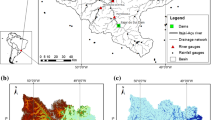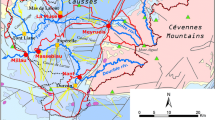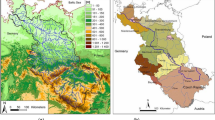Abstract
Flood modelling in transnational rivers requires efficient cross-border collaboration among the riparian countries. Currently, each country/region usually uses a different hydraulic modelling approach, which may hinder the modelling of the entire river. For the sake of accurate and consistent river modelling there is a necessity for the establishment of a framework that fosters international collaborations. This study investigates the current hydraulic modelling approach across the whole length of the River Meuse, the main course of which crosses three north-western European countries. The numerical models used by French, Belgian, and Dutch agencies and authorities were interconnected by exchanging boundary conditions at the borders. At the central part of the river, the Belgian hydraulic model assumed steady flow conditions, while the rest of the river was modelled in unsteady mode. Results for various flood scenarios revealed a distinctive pattern of water depths at the Belgian-Dutch border. To clarify whether this is a bias induced by the change in modelling approach at the border (steady vs. unsteady), we remodelled a stretch of the river across the Belgian-Dutch border using a consistent unsteady modelling approach. The steady and unsteady approaches led to similar patterns across the border, hence discarding the hypothesis of a bias resulting from a change in the employed model. Instead, the pattern in water depths was attributed to a change in the topography of the Meuse Valley, where there is a transition from a narrow steep corridor with limited water storing capacity in Ardennes massif to wide floodplains in the Dutch lowlands. The associated flood damping for the 100-year discharge is less than 1% in the Ardennes and exceeds 15% in the Dutch lowlands. It can be inferred that the current differences in regional hydraulic modelling approaches for the River Meuse are generally well-grounded and not just a legacy of the past.





Similar content being viewed by others
References
Angelidis P, Kotsikas M, Kotsovinos N (2010) Management of upstream dams and flood protection of the transboundary River Evros/Maritza. Water Resour Manag 24:2467–2484
Bakker MHN (2009) Transboundary river floods and institutional capacity. J Am Water Resour Assoc 45:553–566
Bannink A, van der Ploeg M, van Schothorst B, Schauff E (2019) Jaarrapport 2018 / De Maas / Goede bron voor drinkwater / Droogte toont kwetsbaarheid. RIWA - Vereniging van Rivierwaterbedrijven
Becker G, Aerts J, Huitema D (2007) Transboundary flood management in the Rhine basin: challenges for improved cooperation. Water Sci Technol 56:125–135
Becker B, Köngeter J, Klauder WS, Reuter C (2008) Modellierung der Randüberströme zwischen Erftscholle, Rurscholle und Venloer Scholle durch Kopplung von Großraum-Grundwassermodellen (in German). Grundwasser 13:15–26
Becker B, Mens M, van der R, Mark (2018) Impacts of developments in neighbouring countries on the Dutch Meuse. 5th symposium on the hydrological modelling of the Meuse basin. Liege
Biancamaria S, Hossain F, Lettenmaier DP (2011) Forecasting transboundary river water elevations from space. Geophys Res Lett 38:L11401
Booij MJ (2005) Impact of climate change on river flooding assessed with different spatial model resolutions. J Hydrol 303:176–198
Bracken LJ, Oughton EA, Donaldson A, Cook B, Forrester J, Spray C, Cinderby S, Passmore D, Bissett N (2016) Flood risk management, an approach to managing cross-border hazards. Nat Hazards 82:217–240
De Moel H, van Alphen J, Aerts JCJH (2009) Flood maps in Europe – methods, availability and use. Nat Hazards Earth Syst Sci 9:289–301
De Niel J, Van Uytven E, Willems P (2019) Uncertainty analysis of climate change impact on river flow extremes based on a large multi-model ensemble. Water Resour Manag 33:4319–4333
de Wit MJM, van den Hurk B, Warmerdam PMM, Torfs PJJF, Roulin E, and W. P. A. van Deursen. 2007a. Impact of climate change on low-flows in the river Meuse. Clim Chang 82:351–372
de Wit MJM, Peeters HA, Gastaud PH, Dewil P, Maeghe K, and J. Baumgart (2007b) Floods in the Meuse basin: Event descriptions and an international view on ongoing measures. Int J River Basin Manag 5:279–292
Dewals B, Huismans Y, Archambeau P, de Keizer O, Detrembleur S, Erpicum S, Buiteveld H, Pirotton M (2012) Effects of climate change on the river Meuse / Hydraulic modelling from Ampsin to Maaseik and further downstream. AMICE WP1 Report - Action 6 (part 2)
Dewals B, Drogue G, Erpicum S, Pirotton M, Archambeau P (2013) Impact of climate change on inundation hazard along the river Meuse. In: Dewals B, Fournier M (eds) Transboundary Water Management in a Changing Climate. CRC Press, Taylor and Francis Group, Milton Park, pp 19–27
Dimitriadis P, Tegos A, Oikonomou A, Pagana V, Koukouvinos A, Mamassis N, Koutsoyiannis D, Efstratiadis A (2016) Comparative evaluation of 1D and quasi-2D hydraulic models based on benchmark and real-world applications for uncertainty assessment in flood mapping. J Hydrol 534:478–492
Dore J, Lebel L, Molle F (2012) A framework for analysing transboundary water governance complexes, illustrated in the Mekong Region. J Hydrol 466–467:23–36
Drab A, Riha J (2010) An approach to the implementation of European Directive 2007/60/EC on flood risk management in the Czech Republic. Nat Hazards Earth Syst Sci 10:1977–1987
Erpicum S, Dewals B, Archambeau P, Detrembleur S, Pirotton M (2010) Detailed Inundation Modelling Using High Resolution DEMs. Eng Appl Comput Fluid Mech 4:196–208
Fotopoulos F, Makropoulos C, Mimikou MA (2010) Flood forecasting in transboundary catchments using the Open Modeling Interface. Environ Modell Softw 25:1640–1649
Gierk M, Heiland P, Stratenwerth T (2014) Internationales Hochwasserrisikomanagement – zwischen Information und Harmonisierung (in German). In: Heimerl S, Meyer H (eds) Vorsorgender und nachsorgender Hochwasserschutz. Springer Vieweg, Wiesbaden, pp 164–172
Giordano MA, Wolf AT (2002) The world’s freshwater agreements: Historical developments and future opportunities. In: Wolf AT (ed) Atlas of International Freshwater Agreements. United Nations Environment Programme (UNEP), Nairobi
Horritt MS, Bates PD (2002) Evaluation of 1D and 2D numerical models for predicting river flood inundation. J Hydrol 268:87–99
Jacquet P, Raymond M, Martin O, Rouas G (2003) Modélisation des crues de la MEUSE (MEUSE river flood modelling) (in French). La Houille Blanche 6:94–103
Leander R, Adri Buishand T, van den Hurk BJJM, de Wit MJM (2008) Estimated changes in flood quantiles of the river Meuse from resampling of regional climate model output. J Hydrol 351:331–343
Leopardi A, Oliveri E, Greco M (2002) Two-dimensional modeling of floods to map risk-prone areas. J Water Resour Plann Manag 128:168–178
Middelkoop H, Van Asselt MBA, van ’t Klooster SA, Van Deursen WPA, Kwadijk JCJ, Buiteveld H (2004) Perspectives on flood management in the Rhine and Meuse rivers. River Res Appl 20:327–342
Paquier A, Bazin PH, Abderrezzak KEK (2019) Sensitivity of 2D hydrodynamic modelling of urban floods to the forcing inputs: lessons from two field cases. Urban Water J (in-press)
Stelling GS (1984) On the Construction of Computational Methods for Shallow Water Flow, Rijkswaterstaat Communications no 35/1984
Van Alphen J, Martini F, Loat R, Slomp R, Passchier R (2009) Flood risk mapping in Europe, experiences and best practices. J Flood Risk Manag 2:285–292
Van Pelt SC, Swart RJ (2011) Climate change risk management in transnational river basins: The Rhine. Water Resour Manag 25:3837–3861
Vansteenkiste T, Tavakoli M, Ntegeka V, Willems P, De Smedt F, Batelaan O (2013) Climate change impact on river flows and catchment hydrology: a comparison of two spatially distributed models. Hydrol Process 27:3649–3662
Wesselink A, de Vriend H, Barneveld H, Krol M, Bijker W (2009) Hydrology and hydraulics expertise in participatory processes for climate change adaptation in the Dutch Meuse. Water Sci Technol 60:583–595
Wiering M, Verwijmeren J (2012) Limits and borders: Stages of transboundary water management. J Borderl Stud 27:257–272
Wiering M, Verwijmeren J, Lulofs K, Feld C (2010) Experiences in regional cross border co-operation in river management. Comparing three cases at the Dutch–German border. Water Resour Manag 24:2647–2672
Wilcox AC, Escauriaza C, Agredano R, Mignot E, Zuazo V, Otárola S, Castro L, Gironás J, Cienfuegos R, Mao L (2016) An integrated analysis of the March 2015 Atacama floods. Geophys Res Lett 43:8035–8043
Wind HG, Nierop TM, de Blois CJ, de Kok JL (1999) Analysis of flood damages from the 1993 and 1995 Meuse Floods. Water Resour Res 35:3459–3465
Acknowledgements
This study partially builds upon the results of the AMICE project, which was funded through INTERREG IVB.
Author information
Authors and Affiliations
Corresponding author
Ethics declarations
Conflict of Interest
The authors declare that there is no conflict of interest regarding the publication of this paper.
Additional information
Publisher's Note
Springer Nature remains neutral with regard to jurisdictional claims in published maps and institutional affiliations.
Electronic Supplementary Material
ESM 1
(DOCX 19.7 KB)
Rights and permissions
About this article
Cite this article
Kitsikoudis, V., Becker, B.P.J., Huismans, Y. et al. Discrepancies in Flood Modelling Approaches in Transboundary River Systems: Legacy of the Past or Well-grounded Choices?. Water Resour Manage 34, 3465–3478 (2020). https://doi.org/10.1007/s11269-020-02621-5
Received:
Accepted:
Published:
Issue Date:
DOI: https://doi.org/10.1007/s11269-020-02621-5




